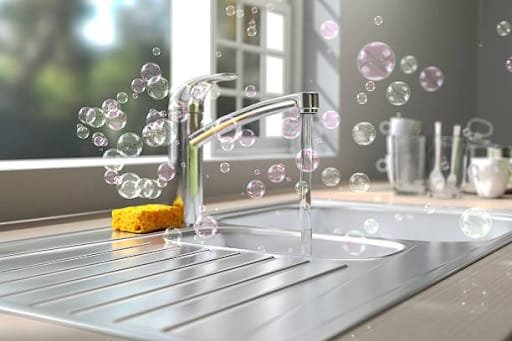The kitchen sink is one of the most essential features of any kitchen. It serves as the main workspace for food preparation, dishwashing, and various other tasks that occur throughout the day. With various designs, materials, and functionalities available, selecting the right kitchen sink, such as a handmade stainless steel kitchen sink, can significantly enhance the efficiency and style of your kitchen. This article explores the different types of kitchen sinks, the materials used, and the factors to consider when choosing the perfect sink for your home.
Understanding Kitchen Sink Types
Kitchen sinks come in several types, each suited for different purposes and aesthetics. Understanding these types will help you make an informed decision.
The single-bowl sink is a popular choice for smaller kitchens or for homeowners who prefer a minimalist approach. This design features one large basin, making it ideal for washing larger pots and pans. The lack of a divider allows for more space, making it easier to wash bigger items without obstruction.
On the other hand, the double-bowl sink is perfect for those who often cook and wash dishes simultaneously. This type features two separate basins, allowing you to wash and rinse dishes in one bowl while preparing food in the other. The division also offers convenience for tasks such as soaking dirty dishes or washing fruits and vegetables.
A more specialized option is the farmhouse sink, known for its large, deep basin and exposed front. This type of sink adds a rustic charm to any kitchen and provides ample space for handling large items. Farmhouse sinks can be found in both single and double-bowl designs, making them versatile for different needs.
Another popular choice is the undermount sink, which is installed beneath the countertop. This style creates a seamless transition between the sink and the countertop surface, making it easier to wipe down crumbs and spills directly into the sink. Under-mount sinks are often paired with solid surface countertops, such as granite or quartz, for a sleek appearance.
Material Choices for Kitchen Sinks
The material of your kitchen sink plays a crucial role in its functionality, durability, and aesthetic appeal. Here are some common materials used for kitchen sinks:
Stainless steel is perhaps the most popular material for kitchen sinks due to its durability, resistance to stains, and ease of maintenance. Stainless steel sinks come in various gauges, with thicker gauges being more durable and less prone to dents. They can complement both modern and traditional kitchen designs.
Another option is porcelain, which offers a classic look that works well in various kitchen styles. Porcelain sinks are typically durable and resistant to scratches, but they can chip if heavy items are dropped on them. Cleaning porcelain sinks is relatively easy, but they may require regular maintenance to keep them looking their best.
Granite composite sinks are a blend of crushed granite stone and acrylic resins, resulting in a highly durable and scratch-resistant surface. These sinks are available in various colours and finishes, allowing you to match them with your kitchen design. Granite composite sinks also offer the appearance of natural stone without the heavy weight.
Cast iron sinks are coated with a layer of enamel, giving them a glossy finish that can be easily cleaned. They are incredibly durable and available in various colours, making them a popular choice for traditional kitchens. However, cast iron sinks can be heavy and may require reinforced cabinetry for support.
Factors to Consider When Choosing a Kitchen Sink
When selecting a kitchen sink, several factors should be taken into account to ensure that you choose one that fits your needs.
First, consider the size of your kitchen and the space available for the sink. Measure the area where the sink will be installed, keeping in mind any cabinets or appliances nearby. A larger sink may be appealing, but it’s essential to ensure that it fits comfortably within the space without overwhelming the kitchen.
Next, think about how you use your sink. If you frequently cook large meals, a double-bowl sink may be more practical, while a single-bowl sink may suffice for light cooking and minimal dishwashing. Assess your cooking habits to determine which type will best suit your lifestyle.
The style of the sink is another important consideration. Your kitchen has a specific design aesthetic, whether it’s modern, traditional, or somewhere in between. Choose a sink that complements your kitchen’s overall look, ensuring that it blends seamlessly with your cabinetry and countertop materials.
Installation type is also critical. If you are renovating your kitchen, you may want to consider whether you prefer an under-mount, top-mount, or farmhouse sink. Each installation method has its benefits, so choose one that aligns with your design goals and practical needs.
Maintenance and Care
Proper maintenance is essential for keeping your kitchen sink in good condition and ensuring its longevity. Different materials require different care, so it’s crucial to understand the specific needs of your sink.
For stainless steel sinks, regular cleaning with mild soap and water is usually sufficient. Avoid using abrasive cleaners or pads, as these can scratch the surface. Wipe the sink dry after each use to prevent water spots and maintain its shine.
Porcelain sinks can be cleaned with gentle abrasives like baking soda or vinegar. Avoid harsh chemicals that can damage the enamel finish. For stubborn stains, a paste of baking soda and water can be effective.
Granite composite sinks should be cleaned regularly with mild soap and a soft cloth. While they are resistant to scratches, it’s still a good idea to use cutting boards to prevent damage. Avoid leaving standing water in the sink for extended periods, as this can lead to discolouration.
Cast iron sinks should be cleaned with mild soap and a soft cloth to maintain the enamel finish. Avoid using abrasive cleaners that can scratch the surface. If you notice any chips or scratches, it’s essential to repair them promptly to prevent rusting.
Conclusion
The kitchen sink is more than just a functional appliance; it is a key element in the overall design and functionality of your kitchen. Understanding the different types and materials available can help you make the right choice for your home. By considering your kitchen’s size, your cooking habits, and the style you want to achieve, you can find the perfect sink that meets your needs.
Regular maintenance will ensure your kitchen sink remains in excellent condition, allowing you to enjoy its benefits for years to come. Whether you opt for a stainless steel sink for its durability, a porcelain sink for its classic appeal, or a farmhouse sink for its rustic charm, the right kitchen sink will enhance your cooking experience and add value to your home.



